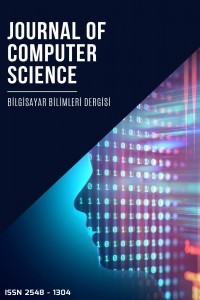Evrişimsel Sinir Ağları ile Konuşmadan Duygu Tanıma Sistemi
duygu tanıma, ses tanıma, konuşma tanıma, evrişimsel sinir ağları
Emotion Recognition System from Speech using Convolutional Neural Networks
emotion recognition, voice recognition, speech recognition, convolutional neural networks,
___
- Andrade, E. B., & Ariely, D. (2009). The enduring impact of transient emotions on decision making. Organizational behavior and human decision processes, 109(1), 1-8.
- Tonguç, G., & Ozkara, B. O. (2020). Automatic recognition of student emotions from facial expressions during a lecture. Computers & Education, 148, 103797.
- Zepf, S., Hernandez, J., Schmitt, A., Minker, W., & Picard, R. W. (2020). Driver emotion recognition for intelligent vehicles: A survey. ACM Computing Surveys (CSUR), 53(3), 1-30.
- César Cavalcanti Roza, V., & Adrian Postolache, O. (2019). Multimodal approach for emotion recognition based on simulated flight experiments. Sensors, 19(24), 5516.
- Saste, S. T. & Jagdale, S. M. (2017). Emotion recognition from speech using MFCC and DWT for security system. International conference of Electronics, Communication and Aerospace Technology (ICECA), Coimbatore, India, pp. 701-704.
- Subhashini, R., & Niveditha, P. R. (2015). Analyzing and detecting employee's emotion for amelioration of organizations. Procedia Computer Science, 48, 530-536.
- Kołakowska, A., Landowska, A., Szwoch, M., Szwoch, W., & Wróbel, M. R. (2013, June). Emotion recognition and its application in software engineering. In 2013 6th International Conference on Human System Interactions (HSI) (pp. 532-539). IEEE.
- Kanjo, E., Younis, E. M., & Ang, C. S. (2019). Deep learning analysis of mobile physiological, environmental and location sensor data for emotion detection. Information Fusion, 49, 46-56.
- Sebe, N., Cohen, I., Gevers, T., & Huang, T. S. (2006, August). Emotion recognition based on joint visual and audio cues. In 18th international conference on pattern recognition (ICPR'06) (Vol. 1, pp. 1136-1139). IEEE.
- Kwon, O. W., Chan, K., Hao, J., & Lee, T. W. (2003). Emotion recognition by speech signals. In Eighth European conference on speech communication and technology.
- Scherer, K. R. (1996, October). Adding the affective dimension: a new look in speech analysis and synthesis. In ICSLP.
- Tato, R., Santos, R., Kompe, R., & Pardo, J. M. (2002). Emotional space improves emotion recognition. In Seventh International Conference on Spoken Language Processing.
- Bakır, C., & Yuzkat, M. (2018). Speech emotion classification and recognition with different methods for Turkish language. Balkan Journal of Electrical and Computer Engineering, 6(2), 122-128.
- Lim, W., Jang, D., & Lee, T. (2016, December). Speech emotion recognition using convolutional and recurrent neural networks. In 2016 Asia-Pacific signal and information processing association annual summit and conference (APSIPA) (pp. 1-4). IEEE.
- Burkhardt, F., Paeschke, A., Rolfes, M., Sendlmeier, W. F., & Weiss, B. (2005, September). A database of German emotional speech. In Interspeech (Vol. 5, pp. 1517-1520).
- Petrushin, V. A. (2000). Emotion recognition in speech signal: experimental study, development, and application. In Sixth international conference on spoken language processing.
- Livingstone, S. R., & Russo, F. A. (2018). The Ryerson Audio-Visual Database of Emotional Speech and Song (RAVDESS): A dynamic, multimodal set of facial and vocal expressions in North American English. PloS one, 13(5), e0196391.
- Cao, H., Cooper, D. G., Keutmann, M. K., Gur, R. C., Nenkova, A., & Verma, R. (2014). Crema-d: Crowd-sourced emotional multimodal actors dataset. IEEE transactions on affective computing, 5(4), 377-390.
- O'Shea, K., & Nash, R. (2015). An introduction to convolutional neural networks. arXiv preprint arXiv:1511.08458.
- Albawi, S., Mohammed, T. A., & Al-Zawi, S. (2017, August). Understanding of a convolutional neural network. In 2017 international conference on engineering and technology (ICET) (pp. 1-6). IEEE.
- ISSN: 2548-1304
- Yayın Aralığı: Yılda 2 Sayı
- Başlangıç: 2016
- Yayıncı: Ali KARCI
Pupil Center Localization Based on Mini U-Net
Akıllı Şebekelerde Dinamik Enerji Fiyatlandırılması Üzerine Bir Çalışma
Derin Öğrenme Tabanlı Görüntü İşleme İle Acil Durum Tespiti
Mustafa GÖKSU, Şafak GÖKSU, Ahmet ALKAN
Beyin Tümörü Bölütleme ve Algılamada Yeni Çekişmeli Üretken Ağ Kullanılması
Sara ALTUN GÜVEN, Muhammed Fatih TALU
Jansen Bağlantısının Kinematik Analizi için Araç Kutusu Tasarımı
Semir SÜNKÜN, Berke Oğulcan PARLAK, Alper YILDIRIM, Hüseyin Ayhan YAVAŞOĞLU
Analysis of Memcapacitor Based Low Pass Filter
Feras DAHROUJ, Sevgi GÜRSUL, Serdar Ethem HAMAMCI
EMG Sinyallerinin HFD Analizi ve Hareket Sınıflandırılması
Gazi AKGÜN, Uğur DEMİR, Alper YILDIRIM
Ecem BÖLÜK, Mustafa Özgür CİNGİZ
Olayla İlgili Potansiyel Sinyalleri Kullanarak Şizofreninin Analizi ve Sınıflandırılması
Anıl AKSÖZ, Doğukan AKYÜZ, Furkan BAYIR, Nevzat Can YILDIZ, Fırat ORHANBULUCU, Fatma LATİFOĞLU
